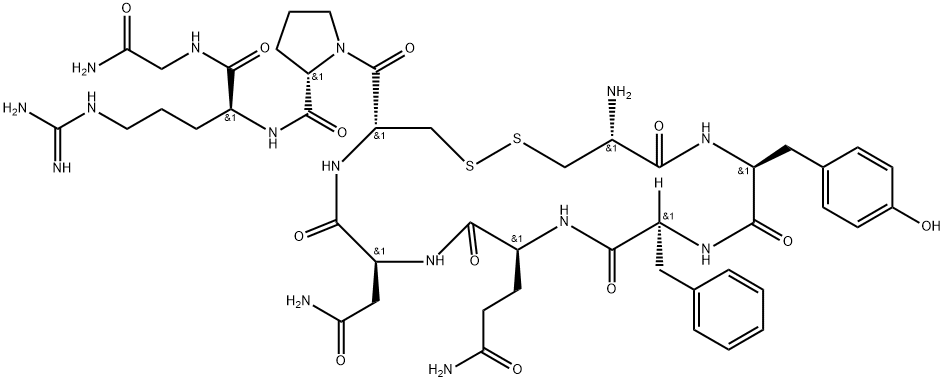Felypressin
Synonym(s):2-L -Phenylalanine-8-L -lysinevasopressin
- CAS NO.:56-59-7
- Empirical Formula: C46H65N13O11S2
- Molecular Weight: 1040.22
- MDL number: MFCD30489730
- EINECS: 200-282-7
- SAFETY DATA SHEET (SDS)
- Update Date: 2024-07-02 08:55:17

What is Felypressin?
Chemical properties
White or almost white, powder or flakes
Originator
Octapressin,Sandoz,W. Germany,1967
The Uses of Felypressin
Felypressin(Octapressin) is a vasopressin 1 agonist and a peptide containing eight amino acids including cystine. Felypressin is used as a vasoconstrictor.
Definition
ChEBI: A synthetic nonapeptide comprising cysteinyl, phenylalanyl, phenylalanyl, glutaminyl, asparaginyl, cysteinyl, prolyl, lysyl, and glycinamide residues in sequence, with a disulfide bridge joining the two cysteine residues. Its antidiuretic effects are less han those of vasopressin. It is used as a vasoconstrictor in local anaesthetic injections for dental use, and is an ingredient of preparations that have been used for treatment of pain and inflammation of the mouth.
Manufacturing Process
Preparation of N-Carbobenzoxy-L-Glutaminyl-L.Asparaginyl-S-Benzyl-LCysteinyl-L-Prolyl-ε-N-p-Toluenesulfonyl-L-Lysylglycinamide: 200 parts by
weight of N-carbobenzoxy-L-prolyl-ε-N-p-toluenesulfonyl-L-lysyl-glycinamide
are dissolved in 1,000 parts by volume of anhydrous acetic acid which has
been saturated with HBr, the mixture allowed to stand for 1 hour at 20°C and
then evaporated under reduced pressure at below 40°C. The residue from this
evaporation is carefully washed with diethyl ether and then added to a
solution of 185 parts by weight of N-carbobenzoxy-L-glutaminyl-L-asparaginyl-
S-benzyl-L-cysteinyl-azide and 48 parts by volume of triethylamine in 1,500
parts by volume of dimethylformamide. The mixture is allowed to stand
overnight at 20°C and the mixture is then poured into twice its volume of
acetone. The precipitate which settles out is filtered off, washed with water,
and recrystallized from dimethylformamide-acetone. There are thus obtained
190 parts by weight of N-carbobenzoxy-L-glutaminyl-L-asparaginyl-S-benzyl-Lcysteinyl-
L-prolyl-ε-N-p-toluenesulfonyl-L-lysyl-glycinamide; MP 165°C
(decomposition).
Preparation of N-Carbobenzoxy-S-Benzyl-L-Cysteinyl-L-Phenylalanyl-LPhenylalanyl-
L-Glutaminyl-L-Asparaginyl-S-Benzyl-L-Cysteinyl-L-Prolyl-ε-N-p-
Toluenesulfonyl-L-Lysyl-Glycinamide: 50 parts by weight of N-carbobenzoxy-Lglutaminyl-
L-asparaginyl-S-benzyl-L-cysteinyl-L-prolyl-ε-N-p-toluenesulfonyl-Llysyl-
glycinamide are dissolved in 400 parts by volume of anhydrous acetic
acid which is saturated with HBr, and the mixture allowed to stand for 1 hour
at 20°C. After evaporating off the solvent under reduced pressure at a
temperature of 35°C (or another temperature below 40°C), the residue is
carefully washed with diethyl ester, whereupon a solution of 32 parts by
weight of N-carbobenzoxy-S-benzyl-L-cysteinyl-L-phenylalanyl-L-phenylalanylazide
and 70 parts by volume of triethylamine in 500 parts by volume of
dimethylformamide is added.
The mixture is allowed to stand for 2 days at 20°C, after which twice its
volume of ethylacetate is added and the resultant precipitate then washed
with warm methanol. There are obtained 45 parts by weight of Ncarbobenzoxy-
S-benzyl-L-cysteinyl-L-phenylalanyl-L-phenylalanyl-L-glutaminyl-
L-asparaginyl-S-benzyl-L-cysteinyl-L-prolyl-ε-N-p-toluenesulfonyl-L-lysylglycinamide;
MP 222°C.
Preparation of L-Cysteinyl-L-Phenylalanyl-L-Phenylalanyl-L-Glutaminyl-LAsparaginyl-
L-Cysteinyl-L-Prolyl-L-Lysyl-Glycinamide: Metallic potassium is
stirred into a solution of 10 parts by weight of N-carbobenzoxy-S-benzyl-Lcysteinyl-
L-phenylalanyl-L-phenylalanyl-L-glutaminyl-L-asparaginyl-S-benzyl-Lcysteinyl-
L-prolyl-ε-N-p-toluenesulfonyl-L-lysyl-glycinamide in 2,500 parts of
dry liquid ammonia at boiling temperature of the solution, until a stable blue
coloration appears. After the addition of 1.8 parts by weight of ammonium
chloride, the solution is evaporated to dryness. The residue of this evaporation
contains the desired L-cysteinyl-L-phenylalanyl-L-phenylalanyl-L-glutaminyl-Lasparaginyl-
L-cysteinyl-L-prolyl-L-lysyl-glycinamide
Preparation of Felypressin: The aforesaid residue, containing the L-cysteinyl-Lphenylalanyl-
L-phenylalanyl-L-glutaminyl-L-asparaginyl-L-cysteinyl-L-prolyl-Llysyl-
glycinamide, is dissolved in 20,000parts by volume of 0.01 normal acetic
acid and is then oxidized by passing air into the solution at a pH of 6.5 to 8.0
for 1 hour. The solution, which contains Felypressin, is adjusted to a pH of 4.0
to 5.0, whereupon 100 parts by weight of sodium chloride are added and the
mixture evaporated to dryness, yielding a dry powder of good stability. It can be stored, and yields a clear solution, e.g., in water or other appropriate
solvent. The solution may be used directly or, if desired, after dilution with
water or a sodium chloride solution
brand name
PLV-2 (Novartis).
Therapeutic Function
Vasoconstrictor
General Description
Felypressin, 2-L-phenylalanine-8-L-lysinevasopressin, has relatively low antidiuretic activity and littleoxytocic activity. It has considerable pressor (i.e., vasoconstrictor)activity, which differs from that of epinephrine (i.e.,following capillary constriction in the intestine it lowers thepressure in the vena portae, whereas epinephrine raises theportal pressure). Felypressin also causes increased renalblood flow in the cat, whereas epinephrine brings about afall in renal blood flow. Felypressin is five times more effectiveas a vasopressor than is lysine vasopressin and is recommendedin surgery to minimize blood flow, especially inobstetrics and gynecology.
Properties of Felypressin
| Melting point: | >197oC (dec.) |
| Boiling point: | 1571.3±65.0 °C(Predicted) |
| Density | 1.288±0.06 g/cm3(Predicted) |
| storage temp. | Keep in dark place,Inert atmosphere,Store in freezer, under -20°C |
| solubility | Freely soluble in water, practically insoluble in acetone and ethanol (96 per cent). It dissolves in dilute solutions of alkali hydroxides. |
| form | neat |
| pka | 12.82±0.70(Predicted) |
| form | Solid |
| color | White |
| CAS DataBase Reference | 56-59-7(CAS DataBase Reference) |
Safety information for Felypressin
Computed Descriptors for Felypressin
New Products
Tert-butyl bis(2-chloroethyl)carbamate 4-Methylphenylacetic acid N-Boc-D-alaninol N-BOC-D/L-ALANINOL N-octanoyl benzotriazole 3-Morpholino-1-(4-nitrophenyl)-5,6-dihydropyridin- 2(1H)-one Furan-2,5-Dicarboxylic Acid DIETHYL AMINOMALONATE HYDROCHLORIDE 1,1’-CARBONYLDIIMIDAZOLE R-2-BENZYLOXY PROPIONIC ACID 1,1’-CARBONYLDI (1,2-4 TRIAZOLE) N-METHYL INDAZOLE-3-CARBOXYLIC ACID (2-Hydroxyphenyl)acetonitrile 4-Bromopyrazole 5-BROMO-2CYANO PYRIDINE 5,6-Dimethoxyindanone 5-broMo-2-chloro-N-cyclopentylpyriMidin-4-aMine 2-(Cyanocyclohexyl)acetic acid 4-methoxy-3,5-dinitropyridine 1-(4-(aminomethyl)benzyl)urea hydrochloride 2-aminopropyl benzoate hydrochloride diethyl 2-(2-((tertbutoxycarbonyl)amino) ethyl)malonate tert-butyl 4- (ureidomethyl)benzylcarbamate Ethyl-2-chloro((4-methoxyphenyl)hydrazono)acetateRelated products of tetrahydrofuran








You may like
-
 Felypressin CAS 56-59-7View Details
Felypressin CAS 56-59-7View Details
56-59-7 -
 1975-50-4 98%View Details
1975-50-4 98%View Details
1975-50-4 -
 2-HYDROXY BENZYL ALCOHOL 98%View Details
2-HYDROXY BENZYL ALCOHOL 98%View Details
90-01-7 -
 2-Chloro-1,3-Bis(Dimethylamino)Trimethinium Hexafluorophosphate 221615-75-4 98%View Details
2-Chloro-1,3-Bis(Dimethylamino)Trimethinium Hexafluorophosphate 221615-75-4 98%View Details
221615-75-4 -
 61397-56-6 CIS BROMO BENZOATE 98%View Details
61397-56-6 CIS BROMO BENZOATE 98%View Details
61397-56-6 -
 14714-50-2 (2-Hydroxyphenyl)acetonitrile 98+View Details
14714-50-2 (2-Hydroxyphenyl)acetonitrile 98+View Details
14714-50-2 -
 118753-70-1 98+View Details
118753-70-1 98+View Details
118753-70-1 -
 733039-20-8 5-broMo-2-chloro-N-cyclopentylpyriMidin-4-aMine 98+View Details
733039-20-8 5-broMo-2-chloro-N-cyclopentylpyriMidin-4-aMine 98+View Details
733039-20-8